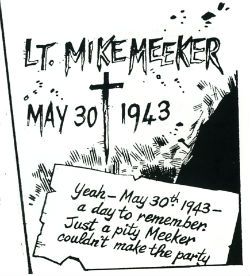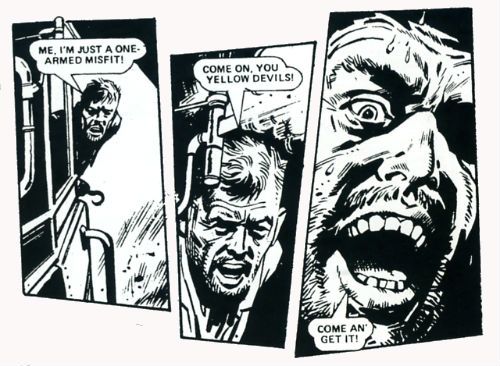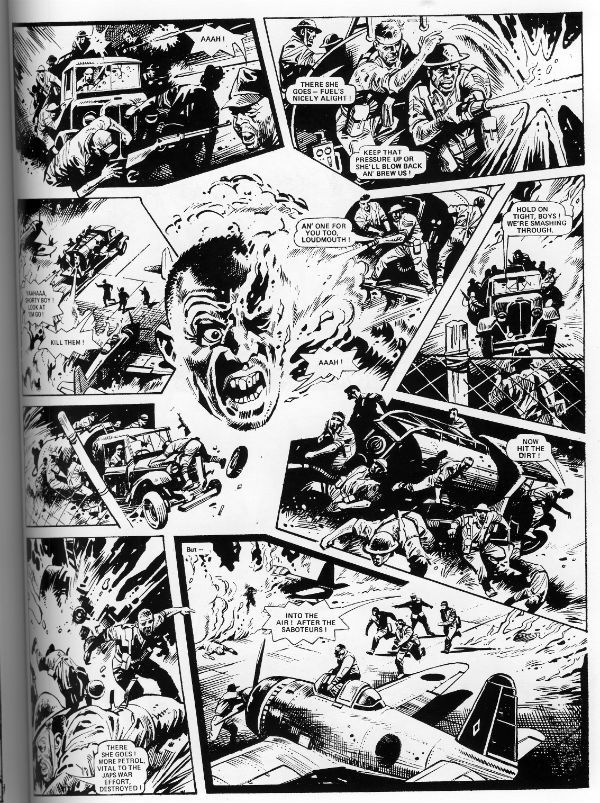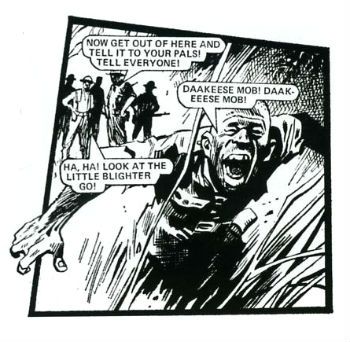"A Tiger Doesn't Give A Buffalo Warning." COMICS! Sometimes They aaaAAAIEEEE!!! DAAKEESE MOB!!
/In the Burmese jungle of 1942 only one thing was more deadly than the Japanese...In the war comics of 1976 only one strip ruled the playground...That thing, that strip was DARKIE’S MOB by Mike Western and John Wagner.
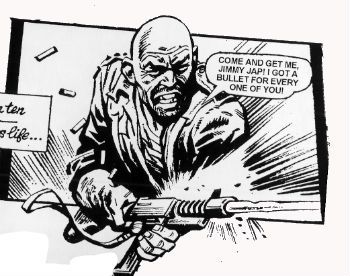 COME ON!!! GET SOME!! CAHMMM AHHHNNNNN!!!!
DARKIE’S MOB: The Secret War of Joe Darkie
Art by Mike Western
Written by John Wagner
Introduction by Garth Ennis
Titan Books, £16.99 (2011)
Darkie’s Mob created by Mike Western and John Wagner
(N.B. Darkie’s character defining shiny pate was the masterstroke of then editor Dave Hunter.)
COME ON!!! GET SOME!! CAHMMM AHHHNNNNN!!!!
DARKIE’S MOB: The Secret War of Joe Darkie
Art by Mike Western
Written by John Wagner
Introduction by Garth Ennis
Titan Books, £16.99 (2011)
Darkie’s Mob created by Mike Western and John Wagner
(N.B. Darkie’s character defining shiny pate was the masterstroke of then editor Dave Hunter.)
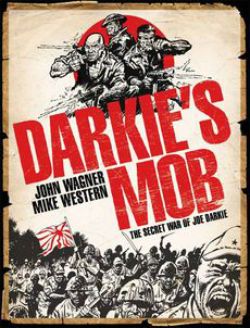 Cover art by Carlos Ezquerra and Mike Western.
Cover art by Carlos Ezquerra and Mike Western.
May 30th 1942: “We’re just sitting. Waiting to die…” Taken from the blood stained pages of the battle log of private Richard Shortland comes the story of Darkie’s Mob. This is the story of Joe Darkie and of the men who followed him into Hell. This is the story of Joe Darkie who wore a dragon against his flesh and hid a demon in his heart. And this is the story, also, of the lost and hopeless men Joe Darkie forged with War into a jungle hard fighting force. And when he was done, when Joe Darkie was finally done, Joe Darkie had taught them that war was Hell but he also taught them that Hell could also be a home. And the Hell of War was the only home there could ever be for DARKIE’S MOB.
 ...and then he'll have to kill you.
...and then he'll have to kill you.
This book contains all the episode of the picto-serial DARKIE’S MOB which originally appeared in issues of BATTLE PICTURE WEEKLY from August 1976 to June 1977. BATTLE was a weekly British war comic aimed primarily at children and it was thus a violent, dark, complex and brutal assault on the pre-teen mind. Which is just how kids like it, social services be damned. So, you've probably guessed Pat “Moderation” Mills was involved but only in that he, together with John Wagner, had set up BATTLE for Fleetway in direct response to the tamer and more typical fare of D C Thompson’s WARLORD. To be fair, when I was a kid WARLORD had its moments but BATTLE still has its moments now I’m an adult, so BATTLE wins. Some might be confused by the fact that during the 1970s there was such an emphasis on the war in British comics. Such people’s confusion would be bolstered by the knowledge that, in addition to BATTLE and WARLORD, there were also the several monthly self-contained digest size titles of BATTLE PICTURE LIBRARY, WAR PICTURE LIBRARY and COMMANDO COMICS.
 "British people In Hot Weather-AH!"
The simplistic and sweeping answer (you were expecting maybe a reasoned thesis?) is that the War still wasn't all that far behind us back then. In fact a notable feature of early BATTLE was that readers were encouraged to send in the war stories of their fathers and grandfathers. (Of course due to natural attrition this feature became less popular as the years wore on). Basically Britain was still trying to process the massive trauma of the conflict and was having a hard time doing so. We’d helped win the thing but it had pretty much broken us and so, yes, it may well have been the 1970s but, sad to admit, the 1940s were taking some shaking. In Renegade the autobiography of (i.e. a fascinating interpretation of his own reality) The Fall’s Mark E. Smith recalls how he used to play Japanese Prisoner of War Camp with the kids he was babysitting. This would involve them having to sit under a table and asking permission of the future Marquis Cha-Cha for any water or food. The kids of Britain in general were not unaffected by the tone of the times, is what I’m getting at there, and BATTLE would reflect this. BATTLE would reflect it in a relatively timely fashion as by 1976 attitudes to the war had changed somewhat and this was, as ever, reflected in the entertainments proffered. The slightly harsh but never too far from cosy early post-WW2 war films embodied by the words “John Mills” had started to give way to bleaker, grimier fare such as Robert Aldrich’s Too Late The Hero. Comics has ever magpied from pop culture after the fact but BATTLE was nimbler than WARLORD on picking up on the changes. WARLORD lagged behind in that it was still Millsian in the sense of Little Johnny but BATTLE was about to forge ahead by virtue of being Millsian in the sense of Pat. DARKIE’S MOB would be one of a number of strips Mills, Wagner, Gerry Finley Day et al would develop and script which would be part of a nation’s acceptance of its own past. Proof that true acceptance had been reached came when war comics fell by the way side. And so the healthy British mindset was to be embodied by a giant killer shark eating surfers like plankton and a fascistic future cop with a chin like a knee but, then, that’s why comics are the best of all things ever. Fact.
"British people In Hot Weather-AH!"
The simplistic and sweeping answer (you were expecting maybe a reasoned thesis?) is that the War still wasn't all that far behind us back then. In fact a notable feature of early BATTLE was that readers were encouraged to send in the war stories of their fathers and grandfathers. (Of course due to natural attrition this feature became less popular as the years wore on). Basically Britain was still trying to process the massive trauma of the conflict and was having a hard time doing so. We’d helped win the thing but it had pretty much broken us and so, yes, it may well have been the 1970s but, sad to admit, the 1940s were taking some shaking. In Renegade the autobiography of (i.e. a fascinating interpretation of his own reality) The Fall’s Mark E. Smith recalls how he used to play Japanese Prisoner of War Camp with the kids he was babysitting. This would involve them having to sit under a table and asking permission of the future Marquis Cha-Cha for any water or food. The kids of Britain in general were not unaffected by the tone of the times, is what I’m getting at there, and BATTLE would reflect this. BATTLE would reflect it in a relatively timely fashion as by 1976 attitudes to the war had changed somewhat and this was, as ever, reflected in the entertainments proffered. The slightly harsh but never too far from cosy early post-WW2 war films embodied by the words “John Mills” had started to give way to bleaker, grimier fare such as Robert Aldrich’s Too Late The Hero. Comics has ever magpied from pop culture after the fact but BATTLE was nimbler than WARLORD on picking up on the changes. WARLORD lagged behind in that it was still Millsian in the sense of Little Johnny but BATTLE was about to forge ahead by virtue of being Millsian in the sense of Pat. DARKIE’S MOB would be one of a number of strips Mills, Wagner, Gerry Finley Day et al would develop and script which would be part of a nation’s acceptance of its own past. Proof that true acceptance had been reached came when war comics fell by the way side. And so the healthy British mindset was to be embodied by a giant killer shark eating surfers like plankton and a fascistic future cop with a chin like a knee but, then, that’s why comics are the best of all things ever. Fact.
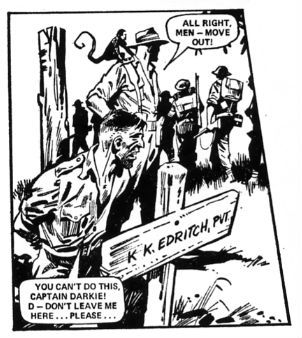 It's okay, he's just joshing...isn't he?
It's okay, he's just joshing...isn't he?
DARKIE’S MOB is a product of the 1970s and so, as this is 2013 when everybody behaves impeccably at all times, Garth Ennis spends most of his informative, knowledgeable and very enthusiastic introduction pointing out that although racist terms are used, they fall within acceptable parameters for the portrayal of a bunch of desperate men at the end of their tethers fighting an enemy it is in their interests to dehumanise. Let’s face it soldiers swear, and sometimes use less than pleasant terms for the people they are trying to kill. There’s no effin’ and jeffin’ here but there are some terms that might make us uncomfortable. And so they should, after all we’re not currently jungle fighting the Japanese are we? Anyway, you have been warned. Ennis also points out that the Japanese army weren't fucking about either. They meant business. In fact, the extent to which they were not fucking about quite surprised the breath out of the British hence they were somewhat on the back-foot when the tale opens. Although, cleverly, the tale is over when it begins and we witness everything via flashbacks spurred by entries in a diary found after the Japanese defeat. Right there on the first page is the clue to how it all ends, and it won’t be ending with kissing nurses in ticker tape parades. Not for Joe Darkie's Mob.
As was usual for strips in British weekly anthologies of the time John Wagner and Mike Western get a whopping three (sometimes four!) pages an episode. Consequently brevity, concision, density and clarity are the order of the day and Western and Wagner obey those orders above and beyond the call of duty. While the initial impact of DARKIE’S MOB will always result from surprise at the savagery of the proceedings its persistence in the reader’s memory is wholly due to the characterisation. No, it’s not exactly Jonathan Franzen, but Wagner nails down the various characters with an enviable certainty and economy. He does this while, in each episode, also delivering at least one explosively violent set piece, hinting at Darkie’s past and keeping a character centric sub plot or two simmering. Wagner is of course known and loved by all comics fans primarily for co-creating Judge Dredd and Strontium Dog but is an excellent comic writer; one whose excellence is often taken for granted due to his comics working so well you often don’t realise how superbly executed they are. To the detriment of his own reputation Wagner always steps back and lets the story take precedence over his personality. Here then is DARKIE’S MOB which is fantastic episodic comic book writing by John Wagner. Oh, the usual warning applies with Brit reprints - it isn't, truthfully, best served by gorging, so maybe put the book aside now and then for the best effect. Self-restraint, I’m talking about self-restraint there. Although that might be difficult given the breakneck velocity built into the strip.
In concert with Wagner’s scripting DARKIE’S MOB benefits enormously from its excellent envisaging by Mike Western. Mike Western is one of a whole host of 70s artists who worked on British comics and whom deserve wider recognition. Thanks to reprints some of them are getting a deserved second wind. This should afford them at least a place in comics history even if it isn’t fully the place they deserve. Carlos Ezquerra’s okay he’s got Judge Dredd (and then all the rest) to keep him in view and Joe Colquhoun isn't going anywhere thanks to Charley’s War and his Johnny Red should give John Cooper a deserved leg up as he shared the strip, but Mike Western’s shot is probably going to be DARKIE’S MOB, so forgive me if I try and make it count. Because it deserves to count because Mike Western is a kind of old school awesome worth celebrating. Western was a stalwart mainstay of the British comics scene with his realistic rather than cartoony work gracing adventure strips and TV tie-ins in titles such as Knockout, Buster, Valiant and, of course BATTLE. Following DARKIE’S MOB Western would continue working in British comics until he officially retired in the ‘90s. He died in 2008. Throughout his career his work was informed by an admiration of artists from over the pond such as Alex Raymond and Milton Caniff. Studying their work would enable him to maximise the limited page space available in British comics but it was his own remarkable talents which make his work in DARKIE’S MOB so successful.
Western served his country in WW2 and while I do not know if any of his experiences are reflected in his art for Darkie’s Mob I kind of hope not for his own sake, what with the claustrophobic sense of sweaty doom he gives the strip. Reportedly Western enjoyed drawing faces and while this is never a bad thing in a comic artist it’s a sure strength when drawing war comics. As the Army isn't noted for encouraging individuality the Mob are largely differentiated by their faces, somewhat in the manner of real human beings. Western’s solid and lifelike fizzogs ground the melodramatic emotions being experienced and enable the retention of a veneer of realism over events that sometimes might stretch belief. Western’s characters are also placed firmly in environments which in a few lines and slabs of black ensure that the reader comes away from DARKIE’S MOB with a sure sense that the book has occurred within the dank folds of a murky jungle Hell. At first glance Western’s art might appear staid and static but when read with Wagner’s words it comes alive, drawing the reader in and pushing the real world out. Proper Comics there, that is. In DARKIE’S MOB with fewer pages than fingers on a wounded hand Western manages to pack in all the desperate and dingy psychodrama Wagner’s script requires in order to sting. He also works those individual panels. Really works them. Mike Western could cram an indecent amount of action, event, character, information and motion into a single panel and if you gave him a whole page to play with? Glad you asked:
DARKIE’S MOB is a raw blast of ‘70s Brit comics Burmese battle action delivered by the masterful team of Mike Western and John Wagner. War is truly terrible but DARKIE’S MOB is VERY GOOD!


